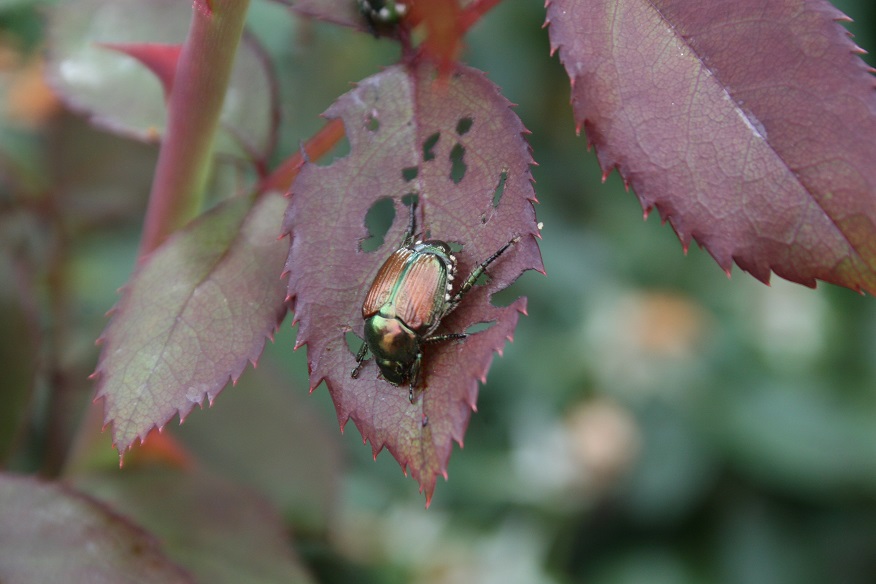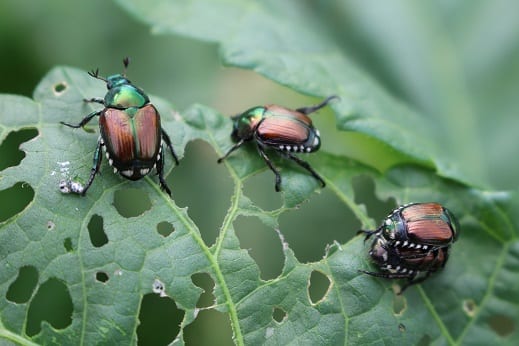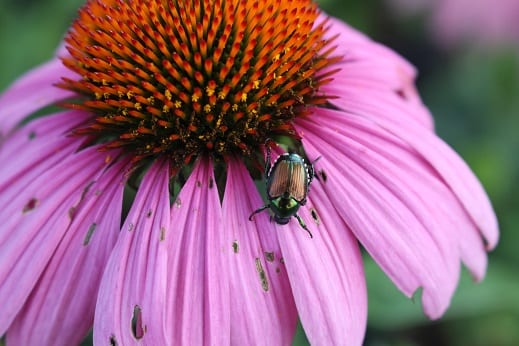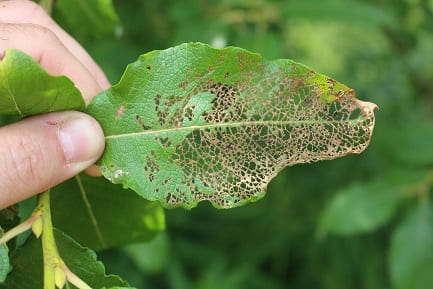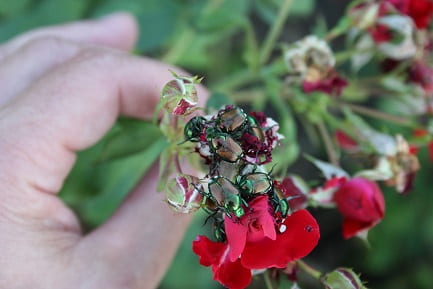REPORT by Dr. Raymond Cloyd Kansas State University Extension Entomology
Japanese beetle adults are out in full-force in certain regions of Kansas feeding on different plant species, but especially roses (Rosa spp.). The means of dealing with the adult stage of Japanese beetle are limited, and have been for many years, with the use of insecticides still being the primary plant protection strategy. Japanese beetle, Popillia japonica is native to Japan and was first reported in the United States in 1916 in the state of New Jersey. Currently, Japanese beetles are established from Maine to Georgia and in nearly every state east of the Mississippi River and several mid-western states.
Japanese beetle, Popilla japonica, adults are present in most regions of Kansas feeding on different plant species, including: roses, Rosa spp.; littleleaf linden, Tilia cordata; and Virginia creeper, Parthenocissus quinquefolia, among many other plant species. The ways to manage populations of the adult stage of Japanese beetle are limited, and have been for many years, with the use of insecticides still being the primary strategy. Japanese beetle adults are one of the most destructive insect pests of horticultural plants in landscapes and gardens. Furthermore, the larva or grub is a turfgrass insect pest in home lawns, commercial settings, and golf courses.
Fig 1. Japanese beetle adults feeding and mating on a leaf (Author–Raymond Cloyd, KSU
There are about 14 tufts of white hair present along the edge of the abdomen (Figure 2).
Fig 2. Japanese beetle adult feeding. Note white tufts of hair along the edge of the abdomen (Author–Raymond Cloyd, KSU).
Adult Japanese beetles emerge from the soil and live up to 45 days feeding on plants over a four-to-six-week period. Adults feed on many horticultural plants including: trees, shrubs, vines, herbaceous annual and perennials, vegetables, fruits, and of course—roses. Plant placement in the landscape and the volatiles emitted by plants are factors that affect adult acceptance. In addition, Japanese beetle adults produce aggregation pheromones that attract males and females to the same feeding location. Adults can fly up to five miles to locate a host plant; however, they tend to only fly short distances to feed and for females to lay eggs.
Japanese beetle adults feed through the upper leaf surface (epidermis) and leaf center (mesophyll), leaving the lower epidermis intact. Adults avoid feeding on tissue between leaf veins, resulting in leaves appearing lace-like or skeletonized (Figure 2).
Fig 2 Japanese Beetle Adult Feeding Damage On Leaf (Auth–Raymond Cloyd, KSU)
They are most active during warm days, feeding on plants exposed to full sun throughout the day, which is likely why roses are a susceptible host plant because roses require at least six hours of direct sunlight to flower. Japanese beetle adults start feeding at the top of plants, migrating downward after depleting food sources. Japanese beetle adults will also feed on flowers (Figure 3),
Fig 3. Japanese Beetle Adults Feeding On Rose Flower (Auth–Raymond Cloyd, KSU)
chewing holes in flower buds, which prevents flowers from opening or causes petals to fall prematurely.
Managing Japanese beetle adult populations involves implementing a variety of plant protection strategies, including: cultural, physical, and applying insecticides. Cultural control is affiliated with maintaining healthy plants through proper irrigation, fertility, mulching, and pruning, which are important in minimizing ‘stress’, and may possibly decrease susceptibility. Moreover, removing weeds that are attractive to Japanese beetle adults such as smartweed (Polygonum spp.) may help to reduce infestations. Physical control involves hand-picking or collecting Japanese beetle adults from plants before populations are extensive. The best time to hand-pick or collect adults is in the morning when ambient air temperatures are typically ‘cooler.’ Adults can be easily collected by placing a wide-mouthed jar or bucket containing rubbing alcohol (70% isopropyl alcohol) or soapy water underneath each adult, and then touching them. Adults that are disturbed fold their legs perpendicular to the body, and fall into the liquid and are subsequently killed. This procedure, when conducted daily or every-other-day, for at least three weeks, particularly after adults emerge, may substantially reduce plant damage. A study reported that collecting Japanese beetle adults daily at 7:00 pm had the greatest impact on populations and reduced subsequent damage.
In general, the use of Japanese beetle traps (Figure 4) in a landscape or garden is not recommended since the floral lure and synthetically-derived sex pheromone may attract more adults into an area than would ‘normally’ occur. Japanese beetle adults may also feed on plants before reaching the traps, which increases potential damage.
Spray applications of contact insecticides will kill Japanese beetle adults. However, repeat applications are required; especially when populations are excessive. Several pyrethroid-based insecticides; such as those containing permethrin (Sevin®), bifenthrin or cyfluthrin as the active ingredient, will suppress Japanese beetle adult populations. However, most of these insecticides will also directly harm many natural enemies (parasitoids and predators) and continual use will result in secondary pest outbreaks of other pests including the twospotted spider mite, Tetranychus urticae. In addition, these insecticides are directly harmful to honey bees and bumble bees. Therefore, applications should be conducted in the early morning or late evening when bees are less active. In general, systemic insecticides are not effective against Japanese beetle adults because they have to feed on leaves and consume lethal concentrations of the active ingredient. If extensive populations are present, plant damage can still occur.
The battle against Japanese beetle adults requires diligence, patience, and persistence, to prevent adults from causing substantial damage to plants in landscapes and gardens.
Hong’s Recommended control
When trying to control Japanese Beetles a multi-step control may be needed.
Apply a spray or liquid to the leaves where they are feeding, apply a granule or dust to the ground beneath plants they are feeding on. Then treat adjacent turf areas for the future grubs.
When the adults are feeding on non-edible plants, systemics are your best bet. Fertilome Tree & Shrub Drench and HiYield Systemic Granules can both can be applied at the base of the plant and watered in, it will do all the work, moving up and into the leaves for long term protection. (Drench, one year. Granules, six to eight weeks.) The HiYield Systemic Insect Spray is intended to be sprayed on the leaves for an almost immediate effect (48 to 72 hrs), but only last six weeks.
In the yard, Grub Free Zone II or III is the most effective control. An application in late May, June or early July will give the best results.
HiYield 38 Plus is not systemic but offers both a contact and long residual control, up to 3 weeks.
In and around edibles, HiYield Lawn, Garden & Pet Spray and Dust are very good options, you may
need to re-apply every rain or watering, see the label for the number of applications allowed.
For an application that will last up to 4 weeks, HiYield Multi-Use Dust is a great product.
![]()
![]()
![]()
![]()
